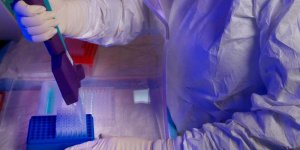| Health / Health News |
NIH scientists and collaborators find infectious prion protein in skin of CJD patients
National Institutes of Health scientists and collaborators at Case Western Reserve University School of Medicine, Cleveland, have detected abnormal prion protein in the skin of nearly two dozen people who died from Creutzfeldt-Jakob disease (CJD). The scientists also exposed a dozen healthy mice to skin extracts from two of the CJD patients, and all developed prion disease.

The brain of one patient who died from sporadic Creutzfeldt-Jacob disease (sCJD) appears nearly identical to the brain of a mouse inoculated with infectious prions taken from the skin of patients who died from sCJD. Image credit: Case Western Reserve University
The study results raise questions about the possible transmissibility of prion diseases via medical procedures involving skin, and whether skin samples might be used to detect prion disease.
CJD is an incurable — and ultimately fatal — transmissible, neurodegenerative disorder in the family of prion diseases. Prion diseases originate when normally harmless prion protein molecules become abnormal and gather in clusters and filaments in the human body and brain.
The reasons for this process are not fully understood. The accumulation of these clusters has been associated with tissue damage that leaves sponge-like holes in the brain. Human prion diseases include fatal insomnia; kuru; Gerstmann-Straussler-Scheinker syndrome; and variant, familial and sporadic CJD.
Using a test for prion diseases known as Real-Time Quaking-Induced Conversion (RT-QuIC), scientists analyzed skin tissue from 38 patients — 23 who had died from CJD, and 15 who died of other causes. They also collected brain tissue from the 23 CJD patients and from seven individuals who died of other causes.
RT-QuIC correctly detected abnormal prion protein in each CJD patient sample tested and in none of the non-CJD group. The scientists noted that in the CJD group, the “seeding potential” for normal prion protein to convert to abnormal was 1,000 to 100,000 times lower in skin than brain tissue.
The scientists then exposed humanized laboratory mice to either brain or skin extracts from two of the CJD patients. All 12 mice inoculated with brain tissue developed prion disease, as did all 12 inoculated with skin extracts, though disease in the skin group took about twice as long — roughly 400 days — to develop. The group also reported that brain degeneration in both groups of infected mice was similar.
The study authors say the results should generate discussion about potential surgical instrument contamination and risk associated with procedures involving CJD patients. (National Institutes of Health)
YOU MAY ALSO LIKE




